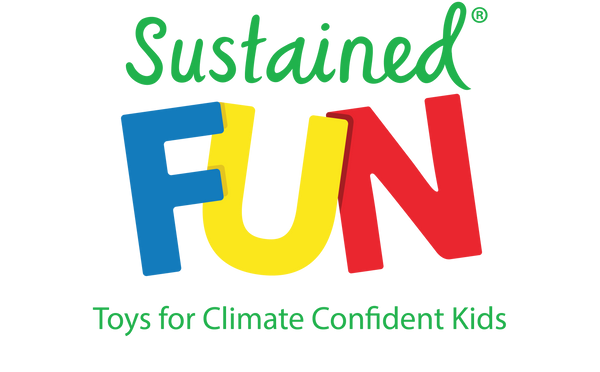Last Earth Day our local library had a display of kids’ books about climate change. My daughter Emma (age 11) and I borrowed a few but were both quite shocked at how negative and depressing they were. One in particular Emma hated because it was filled with pictures of crying children, dying animals and dreary colours. Another she couldn't get past the first page because 'there's just more pictures of sad children'.
Climate change is a serious topic and we shouldn't sugar coat it but publishing books that seem design to spread fear and anxiety is not the answer.
So we started to borrow all the books on climate change to try to find the best ones. Here are our favourites, as reviewed by me (Helen) and Emma.
100 Things to Know about Saving the Planet
UsbourneISBN 978-1-4749-8183-5
 Emma loved this book, once she started reading it she went off to her room, read it cover to cover and then came back asking for a copy.
Emma loved this book, once she started reading it she went off to her room, read it cover to cover and then came back asking for a copy.It covers 100 intriguing projects and activities that are helping the environment and climate change including: Face masks for cows could clean up their burps; Squashed apple skins can be made into shoes; Armies of ducks protect farmers' fields; A massive vacuum cleaner sucks smog from the sky; It'll be game over if we don't stop burning fossil fuels; Frozen time capsules help predict our climate future.
The pictures are bright and interesting, Emma liked the little blue characters on each page and was happy that there was not a single sad person or animal in the book. A wide range of solutions are profiled including conservation, tech, personal choices, activism, governments cooperating and biodiversity.
It’s a Wonderful World
By Jess FrenchISBN 978-0-7440-5018-9
 Emma: I like how it’s got lots of nice friendly cartoon pictures. There’s actually no unhappy pictures in this book. All the animals are happy. It doesn’t start off with bad news. None of this book has bad news except when the bad and the good are next to each other.
Emma: I like how it’s got lots of nice friendly cartoon pictures. There’s actually no unhappy pictures in this book. All the animals are happy. It doesn’t start off with bad news. None of this book has bad news except when the bad and the good are next to each other.
It makes me feel like everything’s going to be ok.
It doesn’t have heaps of things you can do to save the planet: I don’t like books that have too many because it’s too much. All the suggestions are things that I can do, or it says to ask a grown up.
It’s a really good book.
Stuff
By Maddie Moate. Illustrated by Paul BostonISBN 978-0-241-48943-7
 Emma: It’s really cool because it’s got lots of detail but in ways you can understand. It’s got stories from all around the world and at the back it’s got an activity for each one. There are lots of facts and it’s got a good glossary and a ‘Things to Spot’ section. If you’re not sure about climate change it’s got a section with the 3Rs and fossil fuels. I give it 5 stars.
Emma: It’s really cool because it’s got lots of detail but in ways you can understand. It’s got stories from all around the world and at the back it’s got an activity for each one. There are lots of facts and it’s got a good glossary and a ‘Things to Spot’ section. If you’re not sure about climate change it’s got a section with the 3Rs and fossil fuels. I give it 5 stars.
Helen: This book covers how items are made, used and re-used all around the world. Including: Did you know that you can make paper out of elephant poo? And plastic packaging out of seaweed? And did you know that if you throw away an old T-shirt, it can take 200 years to break down?
Climate Change and How We’ll Fix it
By Alice Harman, Illustrated by Andrés LozanoISBN 978-0-7112-5680-4
 Helen: This is a great book that tackles the problem of why we aren’t fixing climate change when we know both what a huge problem it is, and how to fix it. It covers 11 behavioural attitudes that are preventing action on climate change including why companies make decisions that harm the environment, whether it’s fair for rich countries to blame poor countries for high carbon emissions when they’re making products demanded by the rich countries, why politicians subsidise polluting industries, how climate activists sometimes isolate people by being ‘goody-two-shoes’ and how we can’t rely on technology to magically fix climate change.
Helen: This is a great book that tackles the problem of why we aren’t fixing climate change when we know both what a huge problem it is, and how to fix it. It covers 11 behavioural attitudes that are preventing action on climate change including why companies make decisions that harm the environment, whether it’s fair for rich countries to blame poor countries for high carbon emissions when they’re making products demanded by the rich countries, why politicians subsidise polluting industries, how climate activists sometimes isolate people by being ‘goody-two-shoes’ and how we can’t rely on technology to magically fix climate change.
This book encourages listening and empathy, it clearly explains why people react the way they do and presents systemic solutions that prioritise climate justice and cooperation. The solutions focus on asking questions, learning to think critically, listening and trying to understand other people’s points of view. It doesn’t lay all the responsibility at the feet of kids nor does it make the reader feel guilty.
The pictures are colourful and positive with a diverse range of people. I think this might be my favourite kids' book on climate change.

